Tax Residency Analysis for Jack
VerifiedAdded on 2020/03/16
|7
|2005
|56
Report
AI Summary
This report analyzes the tax residency of Jack for the year ending June 30, 2016, based on various tests outlined in the ITAA 1936. It discusses the domicile, resides, superannuation, and 183-day tests to determine Jack's residency status. The report concludes that Jack is a foreign tax resident as he fails to meet the criteria for any of the tests. Additionally, the report computes Jack's taxable income, considering various income sources and allowable deductions, resulting in a total taxable income of A$379,100.
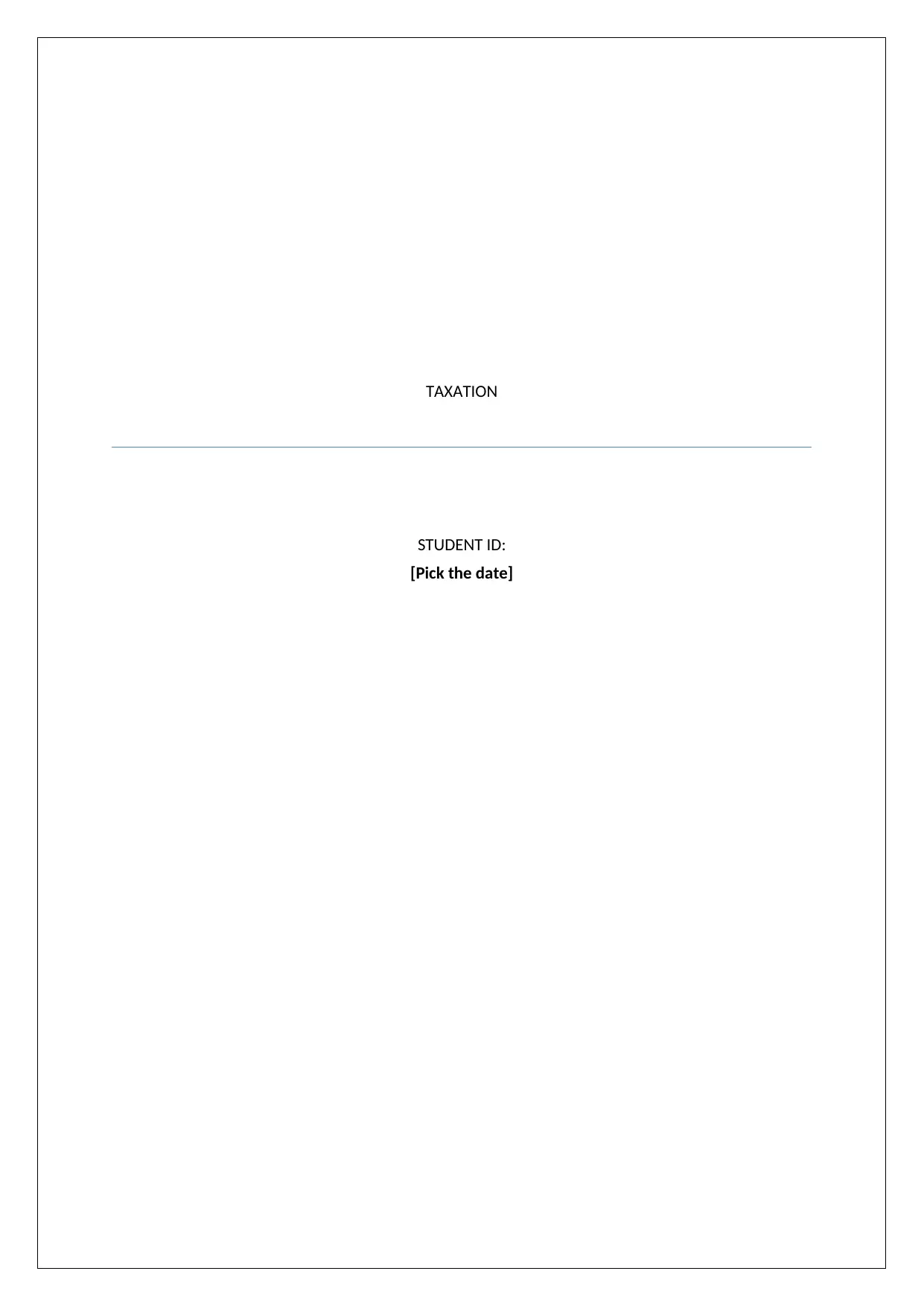
TAXATION
STUDENT ID:
[Pick the date]
STUDENT ID:
[Pick the date]
Paraphrase This Document
Need a fresh take? Get an instant paraphrase of this document with our AI Paraphraser
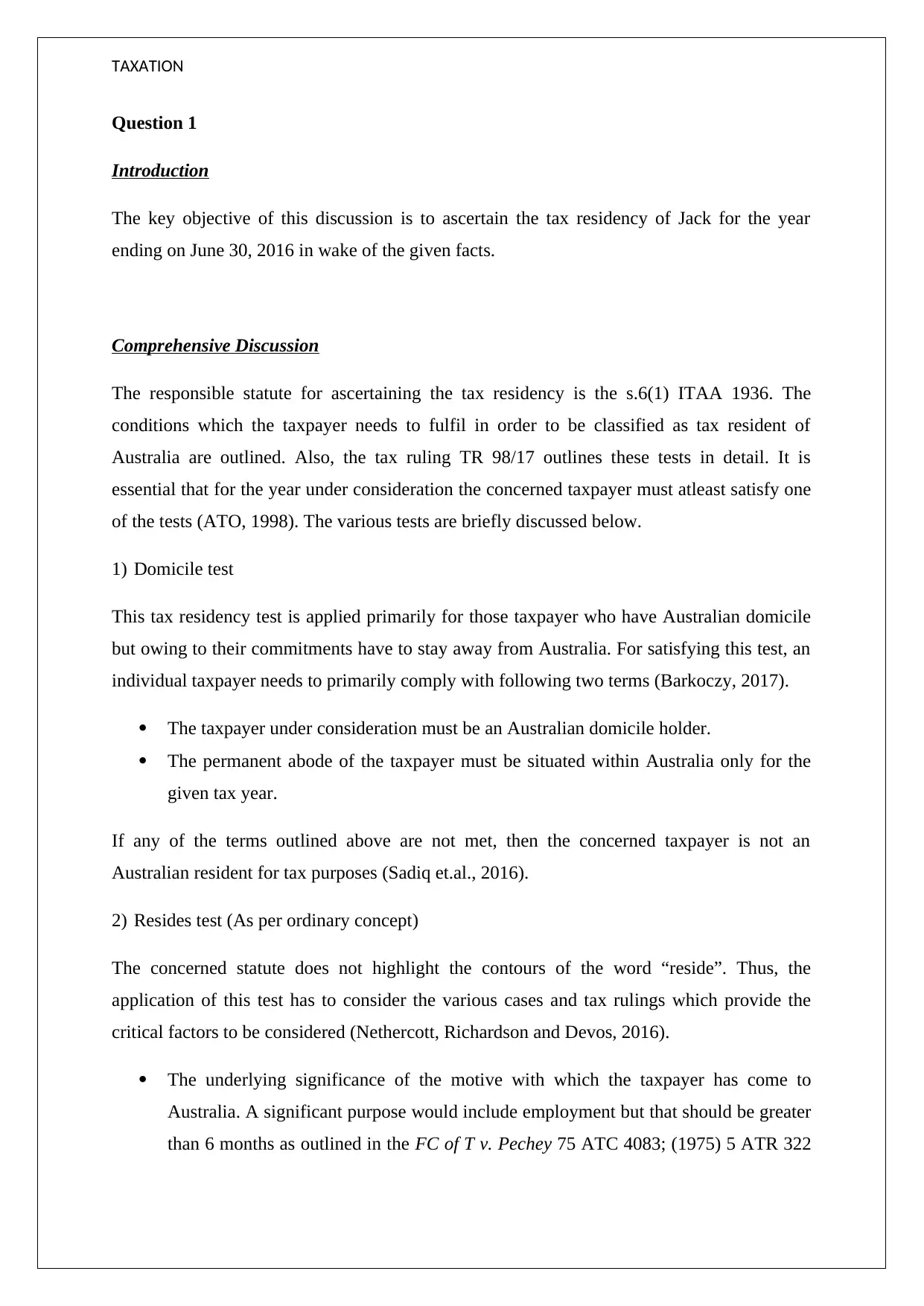
TAXATION
Question 1
Introduction
The key objective of this discussion is to ascertain the tax residency of Jack for the year
ending on June 30, 2016 in wake of the given facts.
Comprehensive Discussion
The responsible statute for ascertaining the tax residency is the s.6(1) ITAA 1936. The
conditions which the taxpayer needs to fulfil in order to be classified as tax resident of
Australia are outlined. Also, the tax ruling TR 98/17 outlines these tests in detail. It is
essential that for the year under consideration the concerned taxpayer must atleast satisfy one
of the tests (ATO, 1998). The various tests are briefly discussed below.
1) Domicile test
This tax residency test is applied primarily for those taxpayer who have Australian domicile
but owing to their commitments have to stay away from Australia. For satisfying this test, an
individual taxpayer needs to primarily comply with following two terms (Barkoczy, 2017).
The taxpayer under consideration must be an Australian domicile holder.
The permanent abode of the taxpayer must be situated within Australia only for the
given tax year.
If any of the terms outlined above are not met, then the concerned taxpayer is not an
Australian resident for tax purposes (Sadiq et.al., 2016).
2) Resides test (As per ordinary concept)
The concerned statute does not highlight the contours of the word “reside”. Thus, the
application of this test has to consider the various cases and tax rulings which provide the
critical factors to be considered (Nethercott, Richardson and Devos, 2016).
The underlying significance of the motive with which the taxpayer has come to
Australia. A significant purpose would include employment but that should be greater
than 6 months as outlined in the FC of T v. Pechey 75 ATC 4083; (1975) 5 ATR 322
Question 1
Introduction
The key objective of this discussion is to ascertain the tax residency of Jack for the year
ending on June 30, 2016 in wake of the given facts.
Comprehensive Discussion
The responsible statute for ascertaining the tax residency is the s.6(1) ITAA 1936. The
conditions which the taxpayer needs to fulfil in order to be classified as tax resident of
Australia are outlined. Also, the tax ruling TR 98/17 outlines these tests in detail. It is
essential that for the year under consideration the concerned taxpayer must atleast satisfy one
of the tests (ATO, 1998). The various tests are briefly discussed below.
1) Domicile test
This tax residency test is applied primarily for those taxpayer who have Australian domicile
but owing to their commitments have to stay away from Australia. For satisfying this test, an
individual taxpayer needs to primarily comply with following two terms (Barkoczy, 2017).
The taxpayer under consideration must be an Australian domicile holder.
The permanent abode of the taxpayer must be situated within Australia only for the
given tax year.
If any of the terms outlined above are not met, then the concerned taxpayer is not an
Australian resident for tax purposes (Sadiq et.al., 2016).
2) Resides test (As per ordinary concept)
The concerned statute does not highlight the contours of the word “reside”. Thus, the
application of this test has to consider the various cases and tax rulings which provide the
critical factors to be considered (Nethercott, Richardson and Devos, 2016).
The underlying significance of the motive with which the taxpayer has come to
Australia. A significant purpose would include employment but that should be greater
than 6 months as outlined in the FC of T v. Pechey 75 ATC 4083; (1975) 5 ATR 322
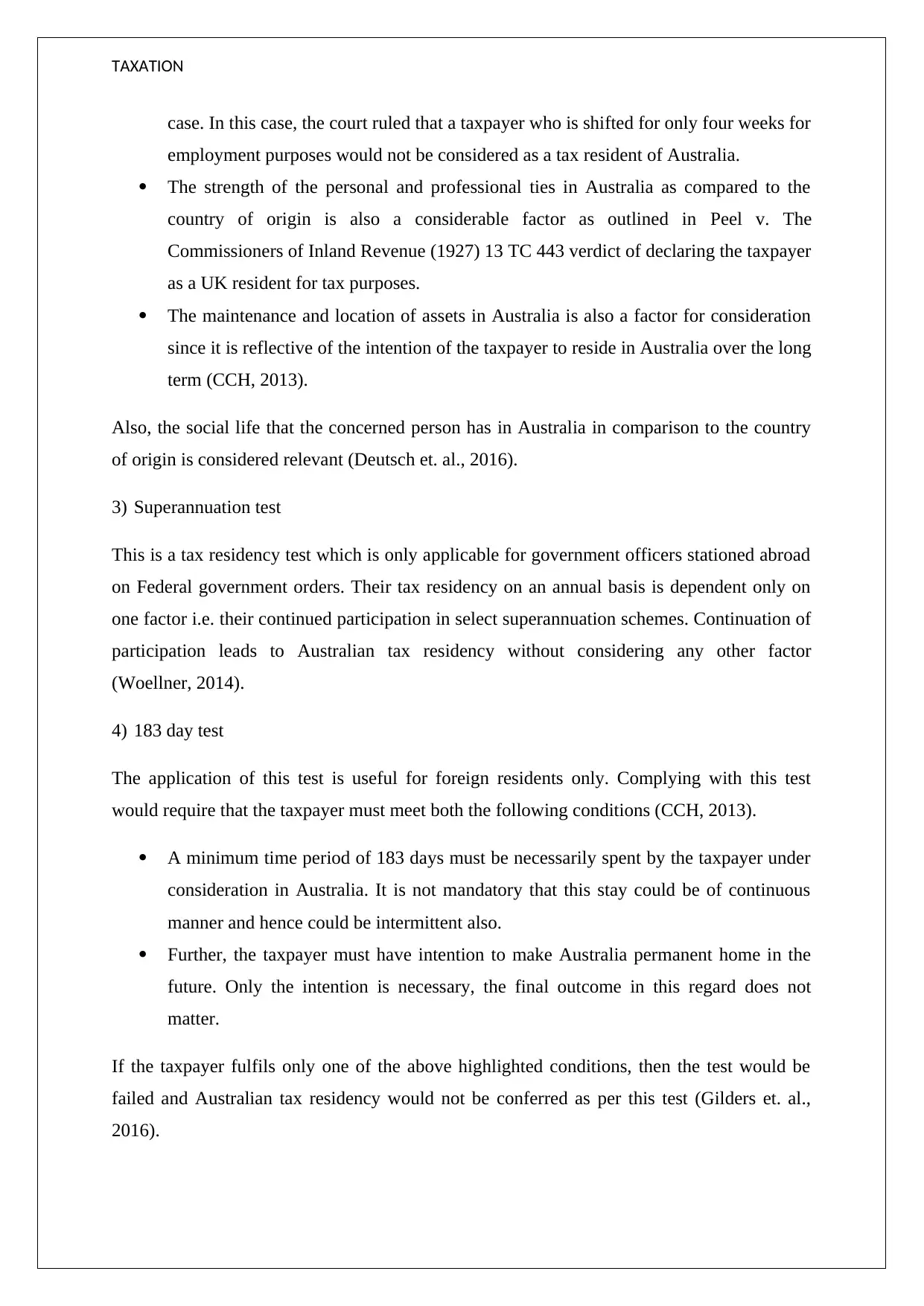
TAXATION
case. In this case, the court ruled that a taxpayer who is shifted for only four weeks for
employment purposes would not be considered as a tax resident of Australia.
The strength of the personal and professional ties in Australia as compared to the
country of origin is also a considerable factor as outlined in Peel v. The
Commissioners of Inland Revenue (1927) 13 TC 443 verdict of declaring the taxpayer
as a UK resident for tax purposes.
The maintenance and location of assets in Australia is also a factor for consideration
since it is reflective of the intention of the taxpayer to reside in Australia over the long
term (CCH, 2013).
Also, the social life that the concerned person has in Australia in comparison to the country
of origin is considered relevant (Deutsch et. al., 2016).
3) Superannuation test
This is a tax residency test which is only applicable for government officers stationed abroad
on Federal government orders. Their tax residency on an annual basis is dependent only on
one factor i.e. their continued participation in select superannuation schemes. Continuation of
participation leads to Australian tax residency without considering any other factor
(Woellner, 2014).
4) 183 day test
The application of this test is useful for foreign residents only. Complying with this test
would require that the taxpayer must meet both the following conditions (CCH, 2013).
A minimum time period of 183 days must be necessarily spent by the taxpayer under
consideration in Australia. It is not mandatory that this stay could be of continuous
manner and hence could be intermittent also.
Further, the taxpayer must have intention to make Australia permanent home in the
future. Only the intention is necessary, the final outcome in this regard does not
matter.
If the taxpayer fulfils only one of the above highlighted conditions, then the test would be
failed and Australian tax residency would not be conferred as per this test (Gilders et. al.,
2016).
case. In this case, the court ruled that a taxpayer who is shifted for only four weeks for
employment purposes would not be considered as a tax resident of Australia.
The strength of the personal and professional ties in Australia as compared to the
country of origin is also a considerable factor as outlined in Peel v. The
Commissioners of Inland Revenue (1927) 13 TC 443 verdict of declaring the taxpayer
as a UK resident for tax purposes.
The maintenance and location of assets in Australia is also a factor for consideration
since it is reflective of the intention of the taxpayer to reside in Australia over the long
term (CCH, 2013).
Also, the social life that the concerned person has in Australia in comparison to the country
of origin is considered relevant (Deutsch et. al., 2016).
3) Superannuation test
This is a tax residency test which is only applicable for government officers stationed abroad
on Federal government orders. Their tax residency on an annual basis is dependent only on
one factor i.e. their continued participation in select superannuation schemes. Continuation of
participation leads to Australian tax residency without considering any other factor
(Woellner, 2014).
4) 183 day test
The application of this test is useful for foreign residents only. Complying with this test
would require that the taxpayer must meet both the following conditions (CCH, 2013).
A minimum time period of 183 days must be necessarily spent by the taxpayer under
consideration in Australia. It is not mandatory that this stay could be of continuous
manner and hence could be intermittent also.
Further, the taxpayer must have intention to make Australia permanent home in the
future. Only the intention is necessary, the final outcome in this regard does not
matter.
If the taxpayer fulfils only one of the above highlighted conditions, then the test would be
failed and Australian tax residency would not be conferred as per this test (Gilders et. al.,
2016).
⊘ This is a preview!⊘
Do you want full access?
Subscribe today to unlock all pages.

Trusted by 1+ million students worldwide
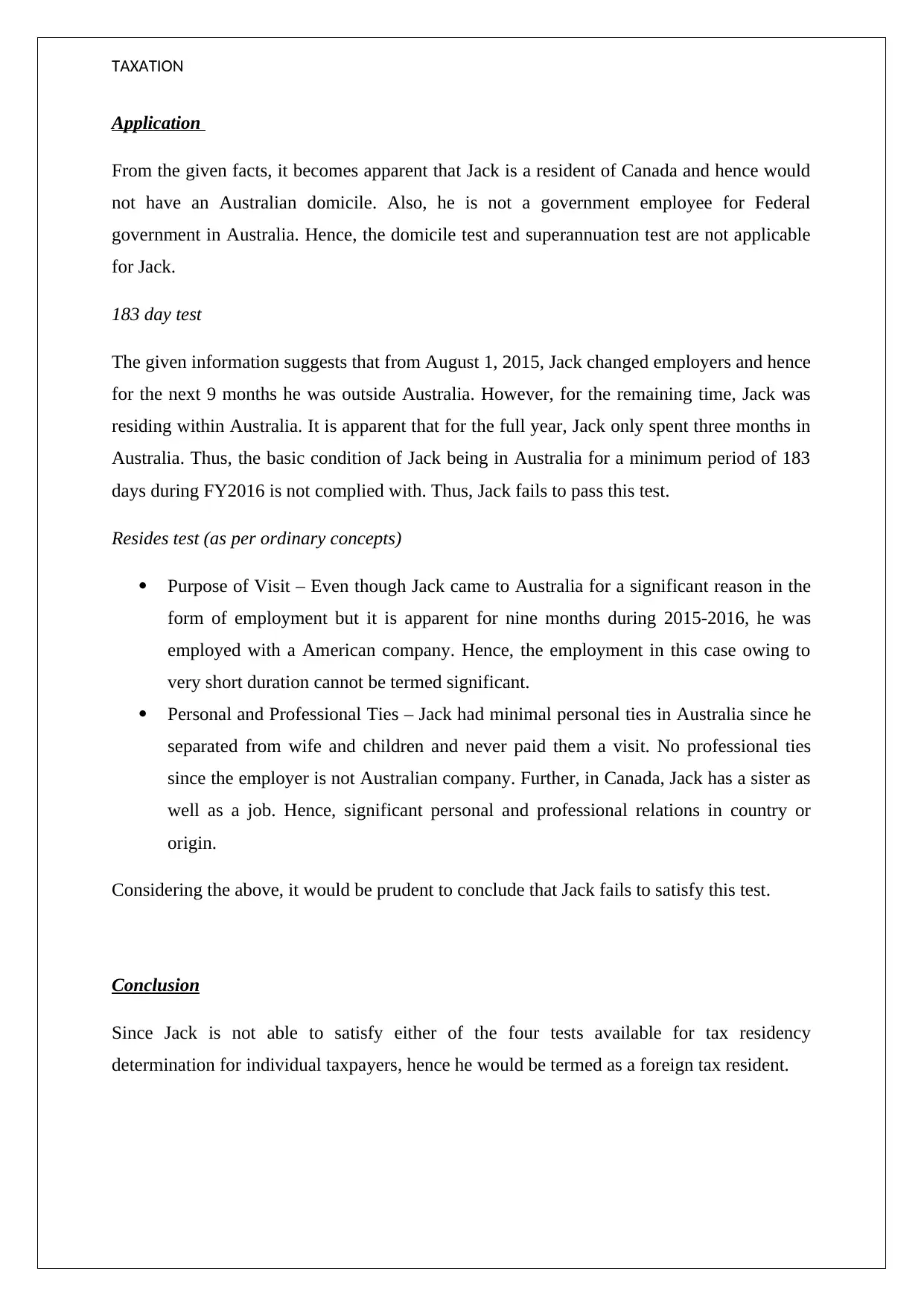
TAXATION
Application
From the given facts, it becomes apparent that Jack is a resident of Canada and hence would
not have an Australian domicile. Also, he is not a government employee for Federal
government in Australia. Hence, the domicile test and superannuation test are not applicable
for Jack.
183 day test
The given information suggests that from August 1, 2015, Jack changed employers and hence
for the next 9 months he was outside Australia. However, for the remaining time, Jack was
residing within Australia. It is apparent that for the full year, Jack only spent three months in
Australia. Thus, the basic condition of Jack being in Australia for a minimum period of 183
days during FY2016 is not complied with. Thus, Jack fails to pass this test.
Resides test (as per ordinary concepts)
Purpose of Visit – Even though Jack came to Australia for a significant reason in the
form of employment but it is apparent for nine months during 2015-2016, he was
employed with a American company. Hence, the employment in this case owing to
very short duration cannot be termed significant.
Personal and Professional Ties – Jack had minimal personal ties in Australia since he
separated from wife and children and never paid them a visit. No professional ties
since the employer is not Australian company. Further, in Canada, Jack has a sister as
well as a job. Hence, significant personal and professional relations in country or
origin.
Considering the above, it would be prudent to conclude that Jack fails to satisfy this test.
Conclusion
Since Jack is not able to satisfy either of the four tests available for tax residency
determination for individual taxpayers, hence he would be termed as a foreign tax resident.
Application
From the given facts, it becomes apparent that Jack is a resident of Canada and hence would
not have an Australian domicile. Also, he is not a government employee for Federal
government in Australia. Hence, the domicile test and superannuation test are not applicable
for Jack.
183 day test
The given information suggests that from August 1, 2015, Jack changed employers and hence
for the next 9 months he was outside Australia. However, for the remaining time, Jack was
residing within Australia. It is apparent that for the full year, Jack only spent three months in
Australia. Thus, the basic condition of Jack being in Australia for a minimum period of 183
days during FY2016 is not complied with. Thus, Jack fails to pass this test.
Resides test (as per ordinary concepts)
Purpose of Visit – Even though Jack came to Australia for a significant reason in the
form of employment but it is apparent for nine months during 2015-2016, he was
employed with a American company. Hence, the employment in this case owing to
very short duration cannot be termed significant.
Personal and Professional Ties – Jack had minimal personal ties in Australia since he
separated from wife and children and never paid them a visit. No professional ties
since the employer is not Australian company. Further, in Canada, Jack has a sister as
well as a job. Hence, significant personal and professional relations in country or
origin.
Considering the above, it would be prudent to conclude that Jack fails to satisfy this test.
Conclusion
Since Jack is not able to satisfy either of the four tests available for tax residency
determination for individual taxpayers, hence he would be termed as a foreign tax resident.
Paraphrase This Document
Need a fresh take? Get an instant paraphrase of this document with our AI Paraphraser
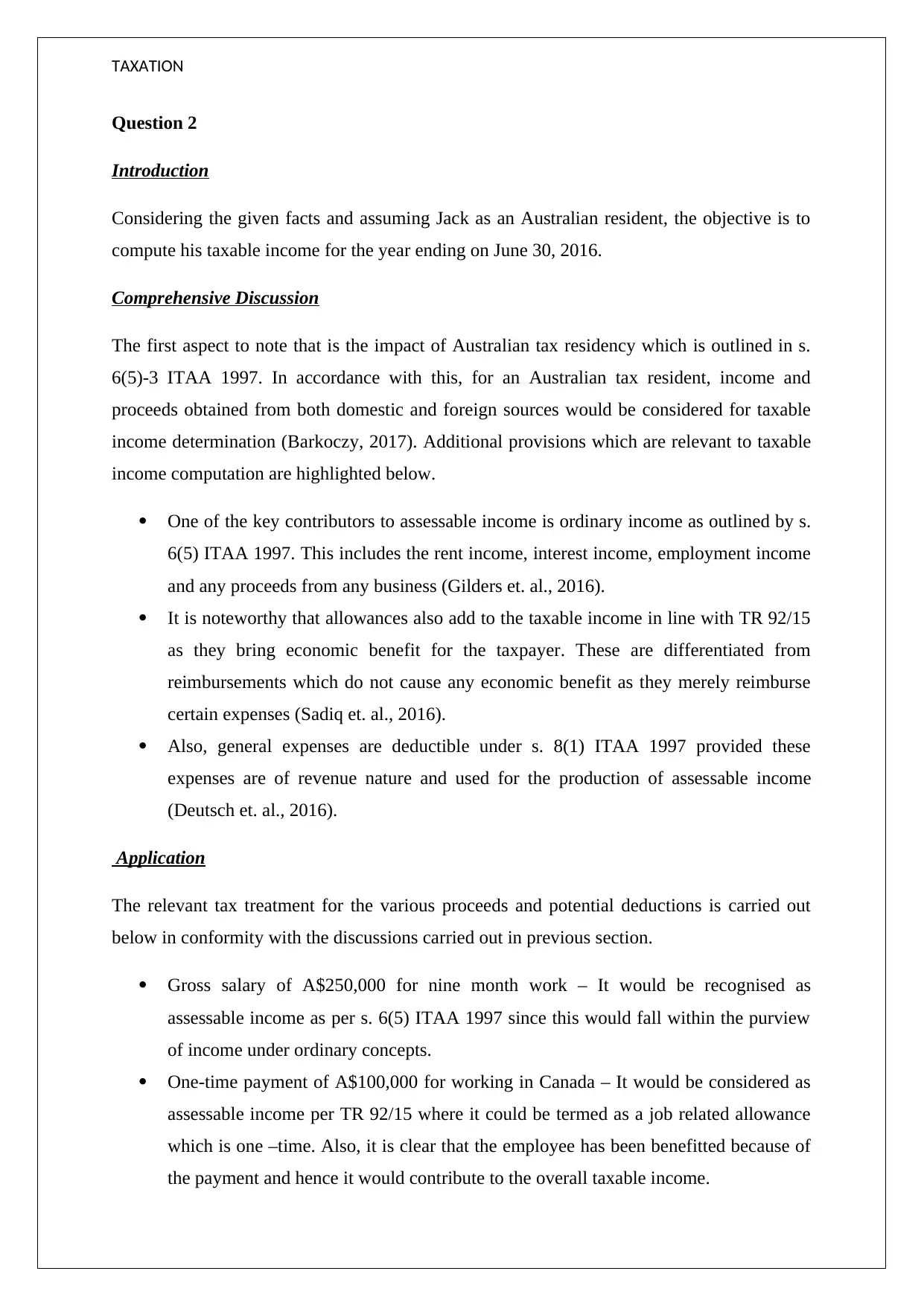
TAXATION
Question 2
Introduction
Considering the given facts and assuming Jack as an Australian resident, the objective is to
compute his taxable income for the year ending on June 30, 2016.
Comprehensive Discussion
The first aspect to note that is the impact of Australian tax residency which is outlined in s.
6(5)-3 ITAA 1997. In accordance with this, for an Australian tax resident, income and
proceeds obtained from both domestic and foreign sources would be considered for taxable
income determination (Barkoczy, 2017). Additional provisions which are relevant to taxable
income computation are highlighted below.
One of the key contributors to assessable income is ordinary income as outlined by s.
6(5) ITAA 1997. This includes the rent income, interest income, employment income
and any proceeds from any business (Gilders et. al., 2016).
It is noteworthy that allowances also add to the taxable income in line with TR 92/15
as they bring economic benefit for the taxpayer. These are differentiated from
reimbursements which do not cause any economic benefit as they merely reimburse
certain expenses (Sadiq et. al., 2016).
Also, general expenses are deductible under s. 8(1) ITAA 1997 provided these
expenses are of revenue nature and used for the production of assessable income
(Deutsch et. al., 2016).
Application
The relevant tax treatment for the various proceeds and potential deductions is carried out
below in conformity with the discussions carried out in previous section.
Gross salary of A$250,000 for nine month work – It would be recognised as
assessable income as per s. 6(5) ITAA 1997 since this would fall within the purview
of income under ordinary concepts.
One-time payment of A$100,000 for working in Canada – It would be considered as
assessable income per TR 92/15 where it could be termed as a job related allowance
which is one –time. Also, it is clear that the employee has been benefitted because of
the payment and hence it would contribute to the overall taxable income.
Question 2
Introduction
Considering the given facts and assuming Jack as an Australian resident, the objective is to
compute his taxable income for the year ending on June 30, 2016.
Comprehensive Discussion
The first aspect to note that is the impact of Australian tax residency which is outlined in s.
6(5)-3 ITAA 1997. In accordance with this, for an Australian tax resident, income and
proceeds obtained from both domestic and foreign sources would be considered for taxable
income determination (Barkoczy, 2017). Additional provisions which are relevant to taxable
income computation are highlighted below.
One of the key contributors to assessable income is ordinary income as outlined by s.
6(5) ITAA 1997. This includes the rent income, interest income, employment income
and any proceeds from any business (Gilders et. al., 2016).
It is noteworthy that allowances also add to the taxable income in line with TR 92/15
as they bring economic benefit for the taxpayer. These are differentiated from
reimbursements which do not cause any economic benefit as they merely reimburse
certain expenses (Sadiq et. al., 2016).
Also, general expenses are deductible under s. 8(1) ITAA 1997 provided these
expenses are of revenue nature and used for the production of assessable income
(Deutsch et. al., 2016).
Application
The relevant tax treatment for the various proceeds and potential deductions is carried out
below in conformity with the discussions carried out in previous section.
Gross salary of A$250,000 for nine month work – It would be recognised as
assessable income as per s. 6(5) ITAA 1997 since this would fall within the purview
of income under ordinary concepts.
One-time payment of A$100,000 for working in Canada – It would be considered as
assessable income per TR 92/15 where it could be termed as a job related allowance
which is one –time. Also, it is clear that the employee has been benefitted because of
the payment and hence it would contribute to the overall taxable income.
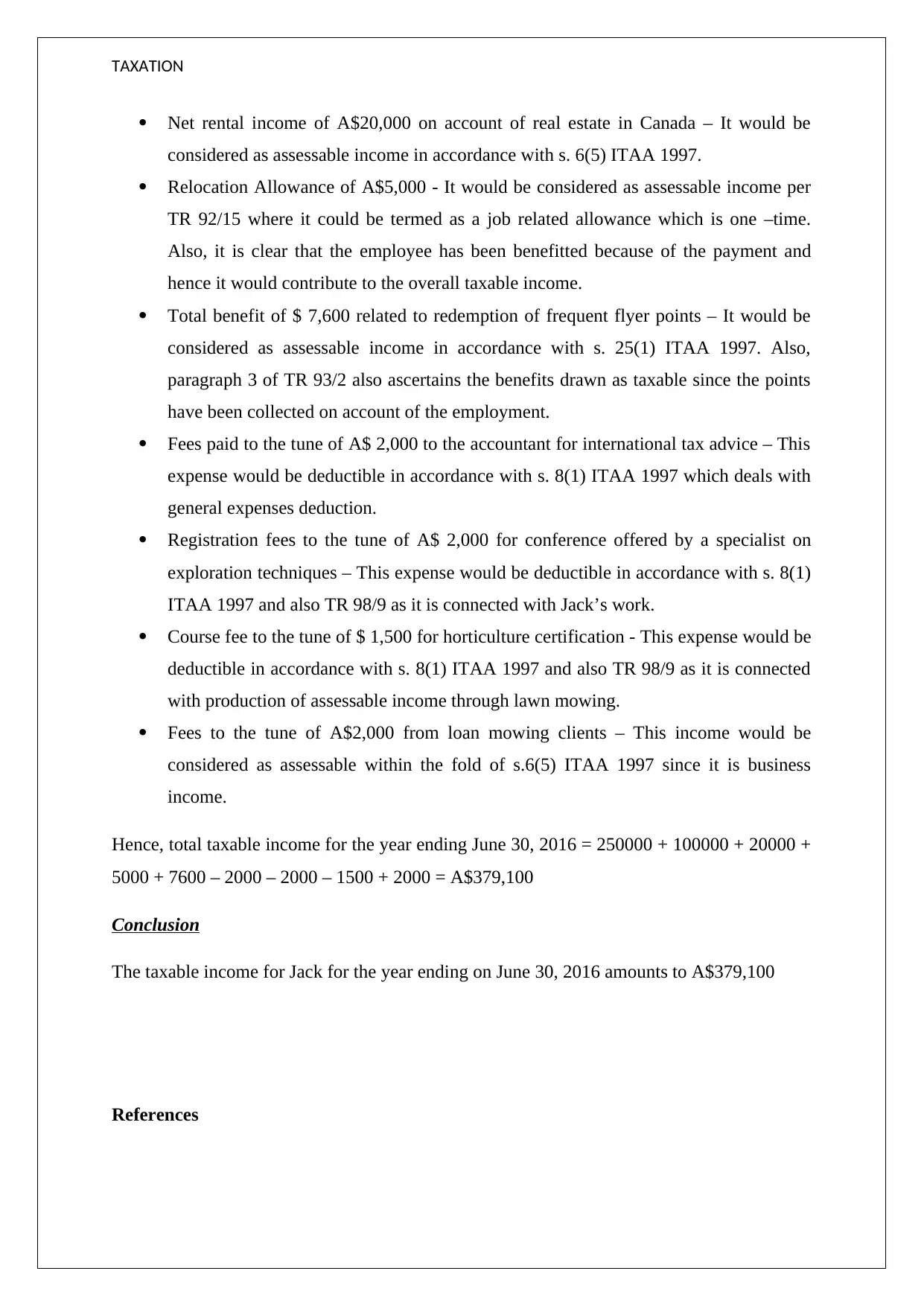
TAXATION
Net rental income of A$20,000 on account of real estate in Canada – It would be
considered as assessable income in accordance with s. 6(5) ITAA 1997.
Relocation Allowance of A$5,000 - It would be considered as assessable income per
TR 92/15 where it could be termed as a job related allowance which is one –time.
Also, it is clear that the employee has been benefitted because of the payment and
hence it would contribute to the overall taxable income.
Total benefit of $ 7,600 related to redemption of frequent flyer points – It would be
considered as assessable income in accordance with s. 25(1) ITAA 1997. Also,
paragraph 3 of TR 93/2 also ascertains the benefits drawn as taxable since the points
have been collected on account of the employment.
Fees paid to the tune of A$ 2,000 to the accountant for international tax advice – This
expense would be deductible in accordance with s. 8(1) ITAA 1997 which deals with
general expenses deduction.
Registration fees to the tune of A$ 2,000 for conference offered by a specialist on
exploration techniques – This expense would be deductible in accordance with s. 8(1)
ITAA 1997 and also TR 98/9 as it is connected with Jack’s work.
Course fee to the tune of $ 1,500 for horticulture certification - This expense would be
deductible in accordance with s. 8(1) ITAA 1997 and also TR 98/9 as it is connected
with production of assessable income through lawn mowing.
Fees to the tune of A$2,000 from loan mowing clients – This income would be
considered as assessable within the fold of s.6(5) ITAA 1997 since it is business
income.
Hence, total taxable income for the year ending June 30, 2016 = 250000 + 100000 + 20000 +
5000 + 7600 – 2000 – 2000 – 1500 + 2000 = A$379,100
Conclusion
The taxable income for Jack for the year ending on June 30, 2016 amounts to A$379,100
References
Net rental income of A$20,000 on account of real estate in Canada – It would be
considered as assessable income in accordance with s. 6(5) ITAA 1997.
Relocation Allowance of A$5,000 - It would be considered as assessable income per
TR 92/15 where it could be termed as a job related allowance which is one –time.
Also, it is clear that the employee has been benefitted because of the payment and
hence it would contribute to the overall taxable income.
Total benefit of $ 7,600 related to redemption of frequent flyer points – It would be
considered as assessable income in accordance with s. 25(1) ITAA 1997. Also,
paragraph 3 of TR 93/2 also ascertains the benefits drawn as taxable since the points
have been collected on account of the employment.
Fees paid to the tune of A$ 2,000 to the accountant for international tax advice – This
expense would be deductible in accordance with s. 8(1) ITAA 1997 which deals with
general expenses deduction.
Registration fees to the tune of A$ 2,000 for conference offered by a specialist on
exploration techniques – This expense would be deductible in accordance with s. 8(1)
ITAA 1997 and also TR 98/9 as it is connected with Jack’s work.
Course fee to the tune of $ 1,500 for horticulture certification - This expense would be
deductible in accordance with s. 8(1) ITAA 1997 and also TR 98/9 as it is connected
with production of assessable income through lawn mowing.
Fees to the tune of A$2,000 from loan mowing clients – This income would be
considered as assessable within the fold of s.6(5) ITAA 1997 since it is business
income.
Hence, total taxable income for the year ending June 30, 2016 = 250000 + 100000 + 20000 +
5000 + 7600 – 2000 – 2000 – 1500 + 2000 = A$379,100
Conclusion
The taxable income for Jack for the year ending on June 30, 2016 amounts to A$379,100
References
⊘ This is a preview!⊘
Do you want full access?
Subscribe today to unlock all pages.

Trusted by 1+ million students worldwide
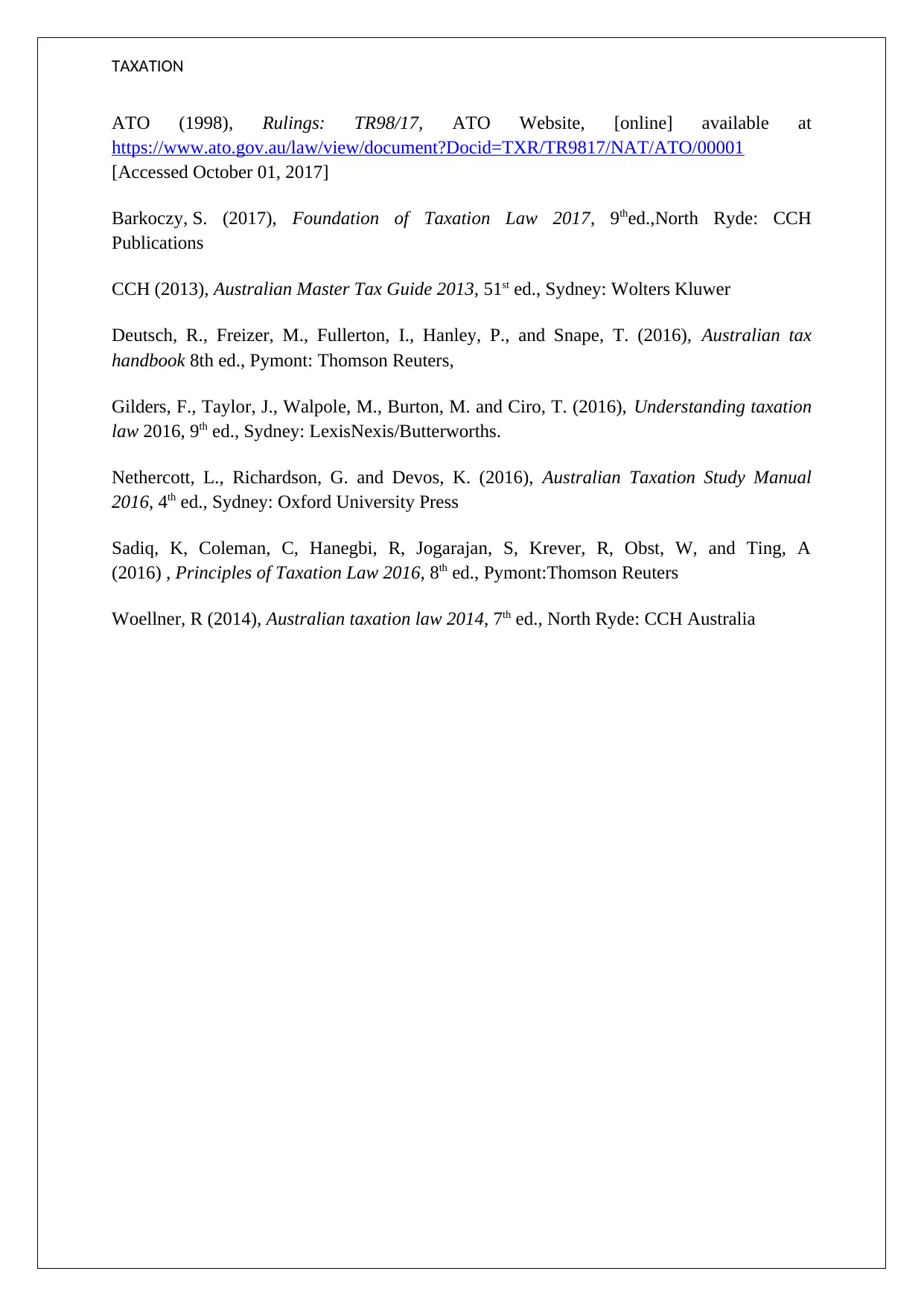
TAXATION
ATO (1998), Rulings: TR98/17, ATO Website, [online] available at
https://www.ato.gov.au/law/view/document?Docid=TXR/TR9817/NAT/ATO/00001
[Accessed October 01, 2017]
Barkoczy, S. (2017), Foundation of Taxation Law 2017, 9thed.,North Ryde: CCH
Publications
CCH (2013), Australian Master Tax Guide 2013, 51st ed., Sydney: Wolters Kluwer
Deutsch, R., Freizer, M., Fullerton, I., Hanley, P., and Snape, T. (2016), Australian tax
handbook 8th ed., Pymont: Thomson Reuters,
Gilders, F., Taylor, J., Walpole, M., Burton, M. and Ciro, T. (2016), Understanding taxation
law 2016, 9th ed., Sydney: LexisNexis/Butterworths.
Nethercott, L., Richardson, G. and Devos, K. (2016), Australian Taxation Study Manual
2016, 4th ed., Sydney: Oxford University Press
Sadiq, K, Coleman, C, Hanegbi, R, Jogarajan, S, Krever, R, Obst, W, and Ting, A
(2016) , Principles of Taxation Law 2016, 8th ed., Pymont:Thomson Reuters
Woellner, R (2014), Australian taxation law 2014, 7th ed., North Ryde: CCH Australia
ATO (1998), Rulings: TR98/17, ATO Website, [online] available at
https://www.ato.gov.au/law/view/document?Docid=TXR/TR9817/NAT/ATO/00001
[Accessed October 01, 2017]
Barkoczy, S. (2017), Foundation of Taxation Law 2017, 9thed.,North Ryde: CCH
Publications
CCH (2013), Australian Master Tax Guide 2013, 51st ed., Sydney: Wolters Kluwer
Deutsch, R., Freizer, M., Fullerton, I., Hanley, P., and Snape, T. (2016), Australian tax
handbook 8th ed., Pymont: Thomson Reuters,
Gilders, F., Taylor, J., Walpole, M., Burton, M. and Ciro, T. (2016), Understanding taxation
law 2016, 9th ed., Sydney: LexisNexis/Butterworths.
Nethercott, L., Richardson, G. and Devos, K. (2016), Australian Taxation Study Manual
2016, 4th ed., Sydney: Oxford University Press
Sadiq, K, Coleman, C, Hanegbi, R, Jogarajan, S, Krever, R, Obst, W, and Ting, A
(2016) , Principles of Taxation Law 2016, 8th ed., Pymont:Thomson Reuters
Woellner, R (2014), Australian taxation law 2014, 7th ed., North Ryde: CCH Australia
1 out of 7
Related Documents
Your All-in-One AI-Powered Toolkit for Academic Success.
+13062052269
info@desklib.com
Available 24*7 on WhatsApp / Email
![[object Object]](/_next/static/media/star-bottom.7253800d.svg)
Unlock your academic potential
Copyright © 2020–2025 A2Z Services. All Rights Reserved. Developed and managed by ZUCOL.





